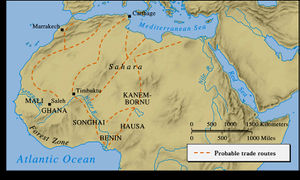Topic 2.4 Trans-Saharan Trade Routes
Jump to navigation
Jump to search
- Trans-Saharan Trade Trans-Saharan trade was another network that would reach its peak in the post-classical age (600 to 1450) when Islam comes to the region. Nevertheless, merchants carried goods across these routes during the classical age, facilitated by the domestication of the camel. Many of the items that were exchanged between Egypt and Nubia in the previous period continued across the Saraha (slaves, gold, and ivory.) One of the most important items that merchants carried to sub-Saharan Africa from North Africa was salt, a needed commodity before refrigeration.
- Trans-Saharan Trade Trans-Saharan trade was another network that would reach its peak in the post-classical age (600 to 1450) when Islam comes to the region. Nevertheless, merchants carried goods across these routes during the classical age, facilitated by the domestication of the camel. Many of the items that were exchanged between Egypt and Nubia in the previous period continued across the Saraha (slaves, gold, and ivory.) One of the most important items that merchants carried to sub-Saharan Africa from North Africa was salt, a needed commodity before refrigeration.
- The Trans-Saharan trade routes that formed in the classical age grew enormously in the period from 600 to 1450 C.E. Here again, Islam played a primary role in this increase. Caravan crossings of the Sahara desert increased the trade in gold, salt, ivory and slaves. Along these same routes, Islam spread to sub-Saharan portions of west Africa. For the first time, empires emerged under the Sarah desert, in large part because Islam brought the means to empower local kings and provide a point of unity. Mansa Musa's famous and extravagant pilgrimage to Mecca gave his kingdom of Mali wide recognition across the Dar al-Islam and served to increase trade connections across the Sahara.
- The Trans-Saharan trade routes that formed in the classical age grew enormously in the period from 600 to 1450 C.E. Here again, Islam played a primary role in this increase. Caravan crossings of the Sahara desert increased the trade in gold, salt, ivory and slaves. Along these same routes, Islam spread to sub-Saharan portions of west Africa. For the first time, empires emerged under the Sarah desert, in large part because Islam brought the means to empower local kings and provide a point of unity. Mansa Musa's famous and extravagant pilgrimage to Mecca gave his kingdom of Mali wide recognition across the Dar al-Islam and served to increase trade connections across the Sahara.
- Land trade increased when people learned to use the power of animals for their benefit. The camel, originally a herd animal, was domesticated in the middle east for its use in the incense trade. Camels extended the scope and volume of trade in the arid Arabian climate. They carried military supplies for the Assyrian armies under the command of Sargon II.[1] These uses of the camel were made possible by the development of a saddle which allowed the animal to be loaded with much cargo. Camels could carry up to 50 percent more cargo than other pack animals, could go longer without water, and lived longer than most of them as well.
- ↑ The Camel and the Wheel (1990), Richard W. Buillet, p. 78.

